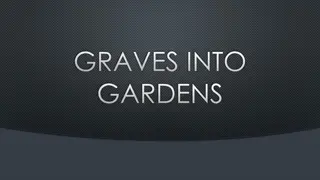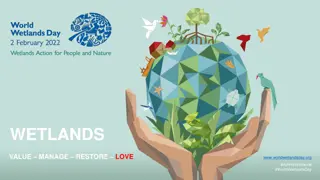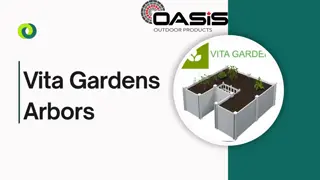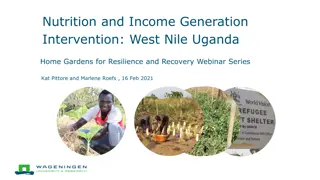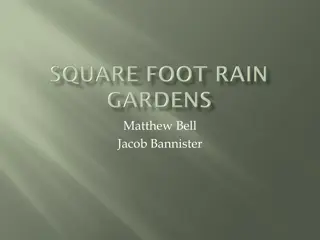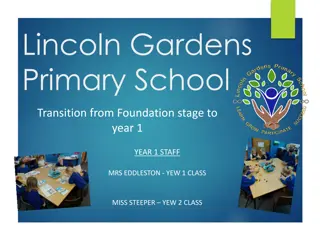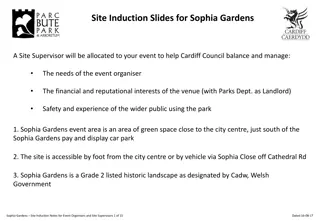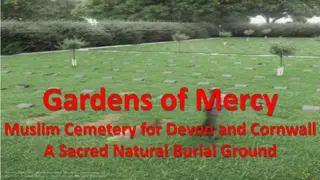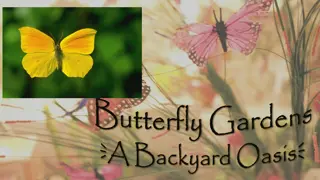The Health Benefits of Nature: From Gardens to the Planet
Discover the importance of nature in promoting human health and well-being. Delve into the concept of biophilia and the innate connections humans seek with natural environments. Learn about the impact of healthy habitats on physical, social, and psychological aspects. Understand the essential role ecosystems play in sustaining life and the urgent need to address the decline of our planet's natural functions due to human activities.
Download Presentation

Please find below an Image/Link to download the presentation.
The content on the website is provided AS IS for your information and personal use only. It may not be sold, licensed, or shared on other websites without obtaining consent from the author.If you encounter any issues during the download, it is possible that the publisher has removed the file from their server.
You are allowed to download the files provided on this website for personal or commercial use, subject to the condition that they are used lawfully. All files are the property of their respective owners.
The content on the website is provided AS IS for your information and personal use only. It may not be sold, licensed, or shared on other websites without obtaining consent from the author.
E N D
Presentation Transcript
The Health Benefits of Nature: From Gardens to the Planet DrTrevor Hancock Professor and Senior Scholar School of Public Health and Social Policy University of Victoria View Royal Garden Club 23 January 2014
Why nature matters Biophilia Dependence on ecosystems Modern and largely urban life leads to Nature deficit disorder The health benefits of nature Beauty and health a new idea Parks and gardens matter 1. 2. 3. 4. 5. 6. 2
Biophilia the connections that human beings subconsciously seek with the rest of life. E.O. Wilson We may have an innate need for nature We evolved in natural environments We seem to have an innate preference for the savannah 3
What are healthy human habitats Habitat selection theory - mobile organisms will prefer fit habitats What environments do humans prefer? Based on 25 years of landscape preference research - environments incorporating natural/green elements Esp savannah, low plants, depth of view etc - the landscape in which we evolved Organisms housed in unfit habitats experience social, psychological and physical breakdown Based on Ming Kuo s presentation at Healthy by Nature, 22 Sept 2011
The ecological determinants of health Nature's goods and services are the ultimate foundations of life and health, even though in modern societies this fundamental dependency may be indirect, displaced in space and time, and therefore poorly recognized. Ecosystems and Human Well-being Millennium Ecosystem Assessment WHO, 2005
Healthy people need healthy ecosystems Ecosystems are the planet's life-support systems - for the human species and all other forms of life. Human biology has a fundamental need for food, water, clean air, shelter and relative climatic constancy. Ecosystems and Human Well-being Millennium Ecosystem Assessment, WHO, 2005
But ecosystems are in decline Human activity is putting such a strain on the natural functions of Earth that the ability of the planet s ecosystems to sustain future generations can no longer be taken for granted. . . . Nearly two thirds of the services provided by nature to humankind are found to be in decline worldwide. Millennium Ecosystem Assessment, 2005
What proportion of time do we spend . . . In an urban setting? 80% Indoors? 90% In vehicles 5% Outdoors? 5% Within a natural ecosystem?
We no longer live in nature We are 80% urbanised We spend 90% of our time indoors And 5% in vehicles So we are only outdoors 5% of the time (= 1 hour/day) And 80% of that is in urban settings Kids don t go out and play 10
Nature deficit disorder From the 2005 book Last Child in the Woods by Richard Louv 11
Roaming distance has shrunk Even as our connectivity to and travel in the wide world has grown! Who knew more about their community?
Time kids spend outdoors There is little Canadian data A 2011 US study of self-reported time in 6 19 year olds found: most children (63%) generally spend at least 2 hours of time outdoors per day Their reported outdoor time was spent playing or just hanging out (84%) biking, jogging or running (80%) and use of electronic media outdoors (65%) Source: Active Healthy Kids Canada 2012 Report Card 13
Earths City Lights Data courtesy Marc Imhoff of NASA GSFC and Christopher Elvidge of NOAA NGDC. Image by Craig Mayhew and Robert Simmon,NASA GSFC
If we cant see the stars . . . Two-thirds of the U.S. population and more than one-half of the European population have already lost the ability to see the Milky Way with the naked eye. The first World Atlas of the artificial night sky brightness, 2001 When a 1994 earthquake knocked out the power in Los Angeles, many anxious residents called local emergency centers to report seeing a strange giant, silvery cloud in the dark sky. What they were really seeing for the first time was the Milky Way, long obliterated by the urban sky glow. Chepesiuk, Env Health Persp 2009
. . . how do we know our place in the universe?
The child-nature connection If we raise a generation of kids with no connection to nature, they won t understand, respect, cherish, nurture or protect nature
The health benefits of nature
Engaging with nature 1. Viewing nature As through a window, or in a painting 2. Being in (the presence of nearby) nature May be incidental to some other activity 3. Active participation and involvement with nature Countryside Recreation Network (UK)
Viewing nature . . . has been linked to Improved recovery in hospital Reduced stress in prison Improved student test scores Reduced job stress, improved job satisfaction Improved mood, reduced anger Relaxed wakefulness , effortless attention Healthy Parks, Healthy People, 2002
Being in nature . . . has been linked to A calming affect - relaxed and peaceful, positive mood Reduced mental fatigue and exhaustion the natural environment has been found to have a restorative quality, particularly for people who live in urban environments. Natural places such as parks offer an opportunity to become revitalised and refreshed. Increased physical activity Healthy Parks, Healthy People, 2002
Health and social benefits of urban greenery Landscape and Human Health Laboratory, U of Illinois - Frances Kuo and colleagues Multiple studies of vegetation, mainly in public housing in Chicago http://lhhl.illinois.edu/
The health impacts of less green environments Social breakdown Less strength of community, courtesy, mutual support, supervision of children outdoors More loneliness, graffiti, noise, litter, loitering, illegal activity, property crime, aggression, violence, violent crime Psychological breakdown Less attention, learning, management of major life issues, impulse control, delay of gratification Greener schools related to better scores, greening schools leads to improved scores More ADHD symptoms, clinical depression, anxiety attacks
Physical breakdown Poorer recovery from surgery, self- reported physical health, immune functioning More obesity in children, physician- diagnosed diseases, mortality Strength of evidence Based on hundreds of studies involving millions of people Multiple methodologies, multiple outcomes Many diverse populations Based on Ming Kuo s presentation Healthy by Nature, 22 Sept 2011 and on Kuo, (2010) Parks and Other Green Environments: Essential Components of a Healthy Human Habitat (National Recreation and Park Association)
Ming Kuos research The greater the amount of greenery in common spaces, the higher the levels of mutual caring and support among neighbours The higher the amount of vegetation, the lower the crime rate Higher levels of residential greenery are associated with lower levels of aggression against domestic artners
Ming Kuos research/2 The more natural the view from home, the better girls scored on tests of concentration and self- discipline The more greenery, the higher levels of optimism and sense of effectiveness The greener the setting in which children with ADD spend time, the more their symptoms are relieved
Vitamin G If this was a drug, we would call it a miracle drug!
Because we are so urbanised The challenge is not how to get people to nature, but how to get nature to people in the settings where they live, learn, work and play Home School Neighbourhood Work Hospital
The Different Environments of Nature and the Different Ways Children and Youth Can Experience Nature (Adapted From the Child and Nature Alliance) Source: Active Healthy Kids Canada (2011)The Active Healthy Kids Canada 2011 Report Card on Physical Activity for Children and Youth. Toronto: Active Healthy Kids Canada. (p 52)
Health benefits of interacting with plants The ability to facilitate healing in the elderly and mentally disadvantaged Improving mental capacity and productivity of people working in offices Improving job and life satisfaction of residents Attracting consumers and tourists to shopping districts, and Aiding community cohesion and identity Healthy Parks, Healthy People, 2002
Nature at home Potted plants Balcony gardens Gardens
Health benefits of gardens and gardening Restorative effect of nature Physical activity Social interaction Gardening clubs Community gardens
Nature at School: Forest Schools & Nature KG Forest School is an educational approach that fosters a connection to, and knowledge of, the natural world through repeated, regular access to local woodland areas, parks and outdoor classrooms through the lens of play-based and child-directed learning. http://www.forestschoolcanada.ca/ Sooke SD 61 Nature KG http://naturekindergarten.sd62.bc.ca/ 36
School grounds and gardens Benefits for students Educational benefits Environmental stewardship and connection with nature Lifestyle and Nutrition School pride Benefits for teachers, schools and communities Active learning and student engagement Student attention and class management Teachers as gardeners Connection to history and the community Source: Tampa Bay School Gardening Network. http://web3.cas.usf.edu/tbsg/benefit sofschoolgardening.aspx 37
Evergreen Foundation - Greening School Grounds Mission - To inspire and enable action to green cities. Brings more than 20 years of experience greening school grounds across Canada http://www.evergreen.ca/en/programs /children/
Nature in the neighbourhood Street trees Neigbourhood gardens Street gardens Institutional greenery Guerrilla gardening Community gardens Parks Etc.
Urban trees and health The four main ways that urban trees affect air quality are: Temperature reduction and other microclimatic effects Removal of air pollutants Emission of volatile organic compounds and tree maintenance emissions Energy effects on buildings David J. Nowak USDA Forest Service, Syracuse, NY http://www.fs.fed.us/ne/syracuse/TREE%20Air%20 Qual.pdf
Health benefits of community gardening Increase community cohesion across cultures across generations reduce graffiti and violence Increase knowledge of nature, food Increase access to healthy food Create restorative spaces Give residents a more positive attitude about themselves and their neighbourhood, resulting in personal and neighbourhood transformation (Based onHealthy Parks, Healthy People, 2002)
Health benefits of urban parks Physical (exercise) Social (being with others) Mental/emotional (relaxation, etc) Spiritual (connecting with nature) Ecological (air quality, temperature regulation etc)
Parks for all Given the inequalities in health we face, how do we ensure the most disadvantaged get the benefits that Vitamin G offers? How do parks meet the needs of ethno-racially diverse communities? Age friendly parks? How do we bring nature indoors?
Nature at work Plants, gardens Daylight Green walls, green roofs Linked to increases in productivity Bio-walls (U of Guelph-Humber) Living machine sewage treatment Body Shop, Toronto
Nature in hospitals Views Pictures Windows (Ulrich, 1984) Plants, fountains Even in an ICU Healing gardens (esp trees, greenery, flowers, water) Reduce stress, improve mood, increase satisfaction (patients, families and staff) Pets See www.Planetree.org
Beauty and health What links Art Nature Cities and the built environment BEAUTY! 46
My early thoughts Every culture has decorative art, music, dance, jewelry Every culture has ideas of beauty and seeks to create beauty So it seems beauty is fundamental to human societies and culture That suggests to me that beauty is likely to be good for health and social wellbeing 48
Ahhh, but what is beauty? Beauty is in the eye of the beholder Challenging, perhaps even dangerous ground 49
The quality present in a thing or person that gives intense pleasure or deep satisfaction to the mind, whether arising from sensory manifestations (as shape, color, sound, etc.), a meaningful design or pattern, or something else (as a personality in which high spiritual qualities are manifest). Dictionary.com 50
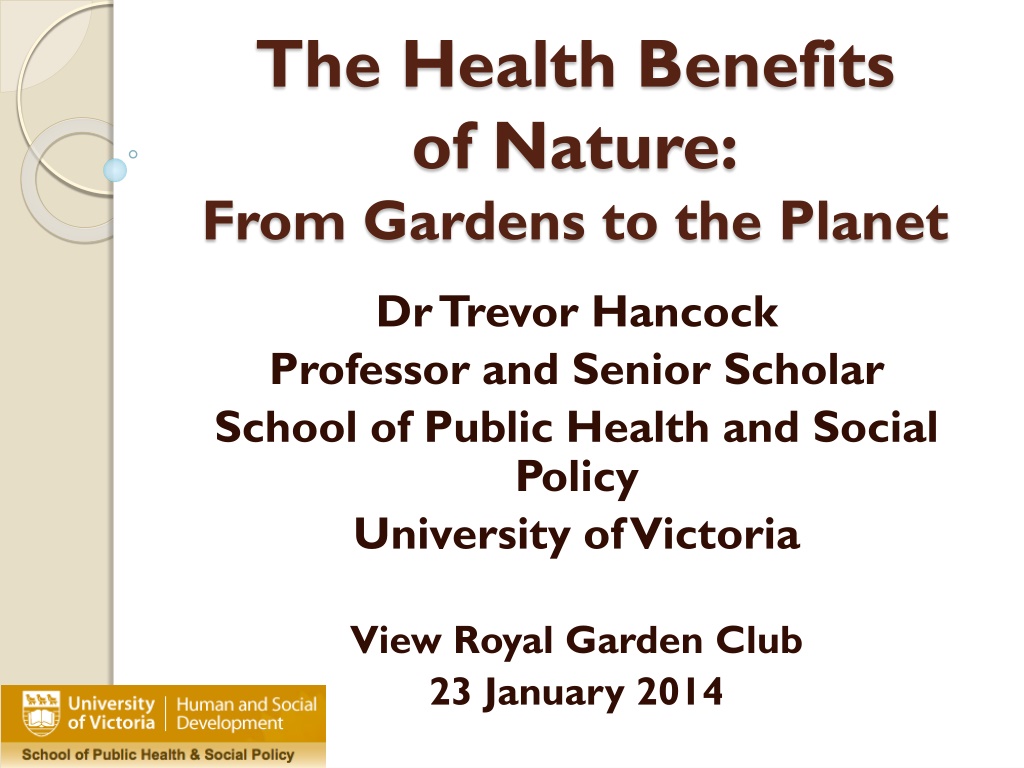













![[PDF⚡READ❤ONLINE] Neptune: The Planet, Rings, and Satellites](/thumb/21522/pdf-read-online-neptune-the-planet-rings-and-satellites.jpg)
![[PDF⚡READ❤ONLINE] Planet Mercury: From Pale Pink Dot to Dynamic World (Springer](/thumb/21549/pdf-read-online-planet-mercury-from-pale-pink-dot-to-dynamic-world-springer.jpg)



